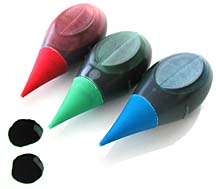|
Key Ingredient
|
Food coloring
 |
Imagine eating Chinese red pork, green salad, Christmas cookies or rainbow shave ice in the dark. Because color and appearance matter, they'd be less appealing. It's scientific: The sight of colorful food fires up the appetite-stimulating neurons in the hypothalmus.
One exception is blue foods. Because there are few delicious and safe blue foods in nature, blue is an appetite suppressant. (Tip for dieters: Color your Spam musubi blue.)
Basics: Saffron, beet juice, rose petals, arsenic and other natural food colors have enhanced recipes for centuries. (Arsenic? Yes. Arsenic and other poisons pop up in ancient cookbooks.)
Fortunately, we now have FDA-approved food colorings at hand to tint our tart glazes and color our cakes.
Uses: The most familiar (and most readily available) food colorings come in boxes of tiny red, yellow, blue and green vials. Our grandmothers used these to color Easter eggs, hard candies, punches and frostings. A drop or two will perk up mango pickles -- and also Chinese red pork and rainbow shave ice.
Gel-paste colors are perfect for cream-based baked goods and candies. Because they're concentrated, a toothpick tip of gel may be all you need in your recipe.
Super-strength powdered colorings work best for candy coatings, icings and decorative sugars that you don't want mixed with water. Professional bakers use powders and other colorings designed especially for their airbrushed masterpieces.
Two terrific food coloring Websites: Candylandcrafts.com provides decorating tips and recipes for lime bars, candy apples, Red Velvet Cake and Green Goddess Dressing, among others. And for Christmas, your keiki can decorate sugar cookies with edible paints, or make tasty clays and finger paints using recipes at mccormick.com.
Selecting: McCormick and Durkee-French are tried-and-true food coloring brands, with Wilton, Spectrum and Chefmaster all excellent choices for gels and powders.
Where to find: Find liquid colorings in your supermarkets' baking sections; gels and powdered colors at kitchen supply stores or online at confectionary sites.
And in case you wondered -- arsenic is red.
![]()
Contact her at the Honolulu Star-Bulletin, 7 Waterfront Plaza,
Suite 210, Honolulu 96813; or e-mail her at features@starbulletin.com
[News] [Business] [Features] [Sports] [Editorial] [Do It Electric!]
[Classified Ads] [Search] [Subscribe] [Info] [Letter to Editor]
[Feedback]
